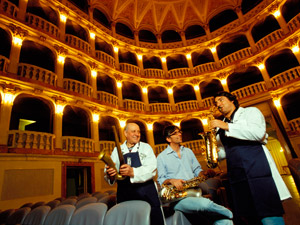An (almost) impossible challenge

It is well-known by all those who know saxophones, that the most sought-after instruments, those with the richest, softest and most enveloping sound, are those which were constructed during the 1950’s and up to the early 1960's. In addition to their uncontested intrinsic qualities, there is the aura that these models have, an aura which has been built up to almost mythical proportions, because in those very decades they were being played by some of the greatest musicians of the twentieth century, musicians who have bequeathed us marvellous and unparalleled sound tracks.
The instruments made subsequent to this period, when the production processes changed from manual to mechanized means, had a less interesting sound quality, and so people continued to play (and look for) the sound that had been created earlier. With the passing of the years, this emotional divide widened more and more, as the Saxophones that were produced differed from the mythical model, and this had the effect of putting that category of instrument on top of every musician’s wish-list.
The manufacturers of professional instruments subsequently designed and marketed Saxophones which were increasingly more sophisticated mechanically and with a more refined intonation. Some of them have tried, by making the sound output easier, to make this aspect the user’s focus of interest. All this however has never fully convinced the hard-core of the world market, musicians who are fascinated and enraptured by vintage instruments and who are prepared, in some cases, to sacrifice both the ergonomic ease of the instrument and the homogeneity of its tuning, just to have that particular depth of sound.
In light of this, to imagine building an instrument which might even approach the vintage Sax of old, appeared not only over-ambitious, but also visionary. This is especially given the fact that talented multinational companies with substantial financial resources and skills available to them, have been forced to set their sights on other characteristics, given the difficulty of closely reproducing the tonal qualities of past models.
The SOUND quality of the Borgani has never been a problem. From this premise, in the late 80's, Orfeo Borgani decided to embark on a project almost impossible to realise: to build professional Saxophones with a modern structure, but which nevertheless carry the unmistakable mark of those legendary times. In order to do this, it was necessary to return to the past, beating and shaping the brass plates, using only the hammer and the experience of the human hand. Thanks to this intuition, the Borgani Company has been able to create instruments which are indeed able to reproduce the sound quality so highly sought-after. The unparalleled manufacturing process has enabled the metal to change for the better, with use and with the passage of time, in a continuous evolution, offering endless subtleties of truly unique sound.
Being constantly confronted with the demands of saxophonists from different musical styles has highlighted the need for a variety of tonal characteristics which offer the musician those features most useful to his or her particular musical style and interpretation. This has led the company to conceptualize and bring about another unique innovation: the sound alloys. Using precise combinations of precious metals, it has become possible to give different timbres and tones to the different instruments.
The full satisfaction of all those musicians - from passionate amateurs to well-known and established professionals- who have chosen to play the Borgani Saxophones, is the greatest reward for having been able to bring to fruition an idea which was as original as it was unlikely- the result of passion, courage and great talent.


